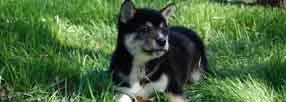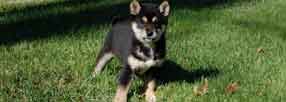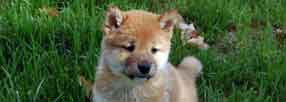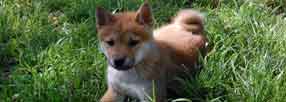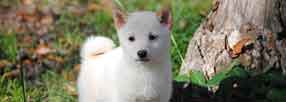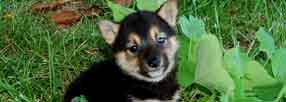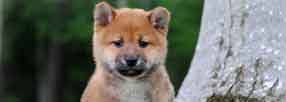|
|
What is Giardia (Giardiasis)What is Giardia?Giardiasis is an intestinal infection caused by a parasitic protozoan (single celled organism) called Giardia lamblia. These protozoans are found in the intestines of many animals, including dogs and humans. This microscopic parasite clings to the surface of the intestine, or floats free in the mucous lining the intestine. Veterinary research documents suggest that 5% to 10% of all dogs in North America have giardiasis at any given time. Surveys also show that about 14% of the adult dog population and over 30% of dogs under one year of age were infected at some point during their life, and thus contributed to passing along this intestinal infection to other dogs. Another Vet research article I found suggests that 100% of kennel dogs, 50% of pups, and 10% of well-cared for dogs carry giardia. Life cycle of GiardiaGiardia occur in two forms: a motile feeding stage that lives in the intestine, and a non-motile cyst stage that passes in the feces. The giardia trophozoite, which is the active stage of the organism - inhabits the small intestine of the dog. The trophozoite stage is tear-drop shaped, binucleated, and has four pairs of flagella. It attaches to the cells of the intestine with its adhesive disc and rapidly divides to produce a whole population of trophozoites. As they detach they may be swept down the intestine. If intestinal flow is fast then they may appear in the feces. However, if they have time, encystment occurs as the parasite travels to the large intestine. The cyst is fairly resistant, and can survive for several months outside of a host's body as long as sufficient moisture is provided. The cyst is oblong in shape with four nuclei that are sometimes distinctly visible. Mature cysts are usually found in the feces of infected animals. Other animals become infected by ingesting the cysts that passed from the body in feces. These ingested cysts then break open inside the small intestine to release the motile feeding stage (trophozoite). Giardia increase their numbers by each organism dividing in half which is called binary fission. How did my dog get Giardia?Giardia lives and reproduces in the small intestine of host animals. Giardia trophozoites, the free living stage of the organism, form infective cysts that are passed out in the feces. If the cysts are present in a wet or damp environment they can survive in a viable state for a few weeks to several months. Giardia infections are transmitted via ingestion of trophozoites or cysts in contaminated water or food. If a giardia cyst is ingested, the cyst wall is broken down during the digestive process and the trophozoite stage begins to colonize the upper small intestine. Transmission also occurs by direct contact, especially with asymptomatic carriers. More recently, giardiasis has also been recognized as being able to be sexually transmitted. Giardia is so prevalent throughout North America because it is highly contagious. The ingestion of as few as one or more giardia cysts may cause the disease, as contrasted to most bacterial illnesses where hundreds to thousands of organisms must be consumed to produce illness. What harm does Giardia do to my dog?Giardia causes its unpleasant effects on the body not by invading the tissues, but simply by being in the way. It multiplies to the point where it sort of paves the lining of the intestine and blocks normal digestion (malabsorption). This causes only partially digested food to get lower in the digestive tract than it should, causing diarrhea. What are the clinical signs associated with infection?The trophozoites divide to produce a large population, then they begin to interfere with the absorption of food. Clinical signs range from none in asymptomatic carriers, to mild recurring diarrhea consisting of soft, light-colored stools, to acute explosive diarrhea in severe cases. Other signs associated with giardiasis are weight loss, listlessness, fatigue, mucus in the stool, and anorexia. These signs are also associated with other diseases of the intestinal tract, and are not specific to giardiasis. These signs, together with the beginning of cyst shedding, begin about one week post-infection. There may be additional signs of large intestinal irritation, such as straining and even small amounts of blood in the feces. Usually the blood picture of affected animals is normal, though occasionally there is a slight increase in the number of white blood cells and mild anemia. Without treatment, the condition may continue, either chronically or intermittently, for weeks or months. How can I be sure my dog has Giardia?Diagnosing giardia is not easy. Diagnosis can be done in one of two ways: via fecal sample by a Vet or via educated evaluation of clinical findings by the breeder/owner or the Vet. Via fecal sample is not straightforward. Even when a flare is at it's worst, the cysts will not be shedding in every single stool. Therefore, a negative report does not rule out giardia. The most thorough way to assess is to collect a sample from every single stool produced for 48 to 72 hours and have a Vet examine it using the giardia test kit. The giardia test is a monoclonal antibody-based ELISA for the rapid detection of Giardia lamblia cysts antigen in stool specimens and serves as an in vitro aid in the diagnosis of giardiasis. How can infection be treated?Infection may be treated using one of a number of different drugs that are available through Vet Supply Stores. The treatment of choice is often with Metronidazole (brand name Flagyl). Metronidazole has two interesting properties--the action is largely confined to the gut and it also seems to stimulate the local immune system. Metronidazole kills off the giardia and reduces the numbers to the level the dog's immune system can handle. Treat all dogs with Metronidazole for 5 days or Fenbendazole for 3 days (Fenbendazole is even safe to use on pregnant and lactating bitches) Thorough cleaning of all kennel areas where infected dogs have access is essential. Once organic debris has been removed, thorough disinfection will help to further reduce the level of environmental contamination and reduce the risk of dogs becoming re-infected after the completion of treatment. Disinfectants containing quaternary ammonium compounds have been found to kill giardia cysts at the manufacturers' recommended dilutions (dilutions of one disinfectant up to 1:704 were found to be effective at both low and high environmental temperatures). I disinfect all my kennels twice per month by washing everything down with a mixture consisting of 8 ounces of Clorox bleach per gallon of water. Make sure you let it set at least 20 minutes, rinse thoroughly, and then let it get completely dry before letting your dog use the kennels again. Important Note: The efficacy of killing is increased by prolonged contact time, therefore disinfectant solution should be left for 20 minutes to half an hour before being rinsed off kennel or run surfaces. Since disinfection of grass runs is impossible, such area should be regarded as contaminated for at least a month after infected dogs last had access. Remember, coccidiosis and giardiasis are both very common protozoal infestations that have the exact same clinical symptoms; therefore, I recommend to follow your vet's instructions. I treat one right after the other. I believe better safe than sorry and prefer treatment for both. |
|
|
|
© 2010-2016 Shiba-Inu-Breeders.com • All Rights Reserved • www.Shiba-Inu-Breeders.com Fair Use Notice: This site may contain copyrighted material whose use has not been specifically authorized by the copyright owners. We believe that this not-for-profit, educational use on the Web constitutes a fair use of the copyrighted material (as provided for in section 107 of the US Copyright Law). If you wish to use this copyrighted material for purposes of your own that go beyond fair use, you must obtain permission from the copyright owner. |






